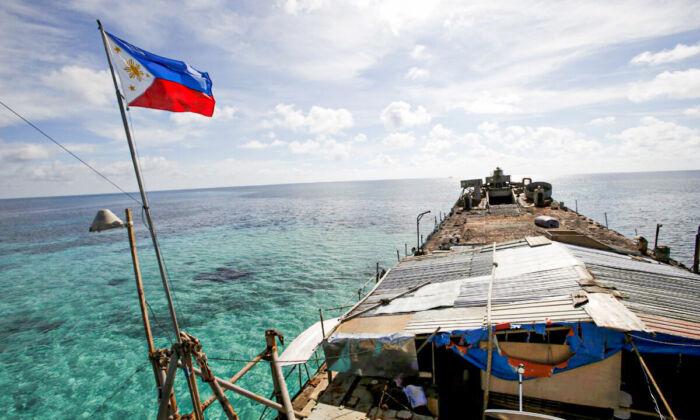The Philippines has begun talks with the United States and Australia over possible joint maritime patrols in the disputed South China Sea to counter Beijing’s growing assertiveness in the region.
Australian Deputy Prime Minister Richard Marles—who concurrently serves as defense minister—met with Philippine Defense Secretary Carlito Galvez in Manila last week to discuss strengthening bilateral defense relations between the two nations.
Marles said they agreed to explore ways to pursue “joint patrols together in the South China Sea” and conduct “more exercises together.”
Both nations are “deeply invested” in upholding the U.N. Convention on the Law of the Sea, which classifies maritime areas within 200 nautical miles of coastal nations’ borders as part of their exclusive economic zones.
Marles also emphasized the need to maintain rules-based order in the South China Sea, through which most of Australia’s maritime trade traverses.
“As countries which are committed to the global rules-based order, it is natural that we should think about ways in which we can cooperate in this respect,” he said during a joint press conference.
“And so we did talk today about the possibility of exploring joint patrols, and we will continue that work, and we hope that that comes to fruition soon.”
Australia will send “one of its largest contingents” to join the U.S.–Philippine annual joint military exercise, while the Philippines will send its observers to join Exercise Talisman Sabre—a multinational military drill led by Australia and the United States—according to Marles.
Galvez said that Australia and the Philippines had conducted joint patrols in the past, particularly at the Celebes and the Sulu Seas.
Reviving Joint Patrols
Prior to the meeting, Galvez spoke by phone with U.S. Defense Secretary Lloyd Austin to discuss the resumption of joint maritime activities in the South China Sea.The Philippine vessel was assisting a navy resupply mission in Ayungin Shoal, also known as the Second Thomas Shoal, of the Spratly Islands when the Chinese ship beamed a green laser light at it, temporarily blinding the crew onboard.

Austin reiterated that any armed attack on Philippine armed forces, public vessels, or aircraft would invoke U.S. mutual defense commitments.
He reaffirmed the U.S. commitment to bolstering the Philippines’ defense capabilities and capacity “to resist coercion.”
The two leaders also discussed opportunities to expand security cooperation “with like-minded nations, such as Japan, that seek to uphold the rules-based international order,” the Pentagon said.
U.S.–Philippine joint patrols were suspended in 2016 by former Philippine President Rodrigo Duterte, who sought to deepen ties with Beijing. His successor, Ferdinand Marcos Jr., however, pledged to bolster ties with the United States, which he regards as “a Pacific power.”
The Philippine Coast Guard (PCG) said on Feb. 17 that it deployed its largest vessel, the BRP Teresa Magbanua, on the orders of Marcos to increase Philippine maritime operations and presence in the South China Sea.
The PCG deployed the vessel on Feb. 2 in the Kalayaan Island Group, which is part of the Spratly archipelago, and advised Filipino fishermen to radio PCG or the Philippine armed forces if they require any assistance.
Vietnam, Malaysia, Taiwan, and Brunei have also clashed with the Chinese regime over its claims in the sea.





